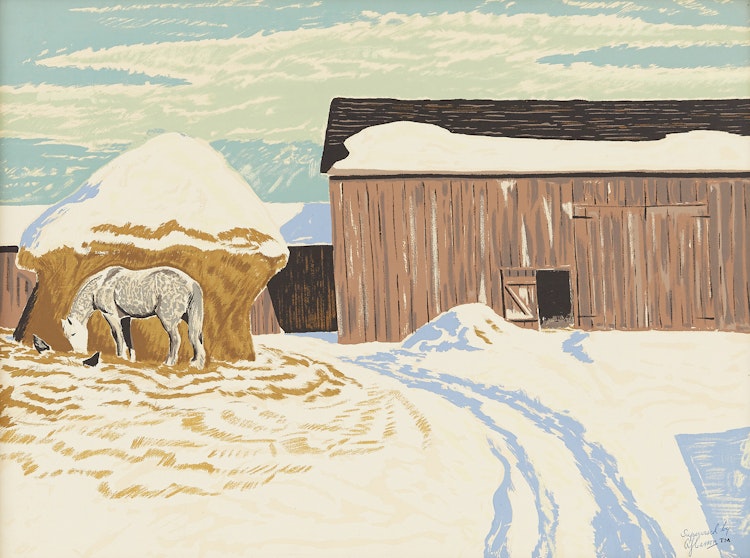
Thoreau MacDonald, born in 1901 near Toronto, Ontario, was a Canadian artist whose work was deeply influenced by his father, the renowned painter J.E.H. MacDonald, a member of the Group of Seven. Growing up surrounded by art and nature, Thoreau developed a unique artistic style that celebrated the simplicity and beauty of the Canadian landscape.
Early Life and Influences
Thoreau was the only son of J.E.H. MacDonald and Harriet Joan Lavis. His early years were marked by a significant move to England in 1904, where his father worked as a book illustrator for Carleton Studios. Upon returning to Canada in 1907, the MacDonald family settled near High Park and the Humber Valley. It was here that Thoreau began accompanying his father on sketching trips, developing an early connection with the natural world that would later define his art.
The MacDonalds moved to Thornhill in 1913, and Thoreau attended public school there. His childhood experiences in the countryside provided him with a deep appreciation for nature, which became a central theme in his work. At 15, Thoreau took on the role of a farmhand, a job he held for six years. This period further strengthened his bond with the land, which would later be reflected in his detailed and evocative depictions of rural life.
Artistic Development
Thoreau’s interest in art was nurtured by the creative environment in which he was raised. His father’s studio was in The Studio Building, a hub for many of the artists who would later form the Group of Seven. Thoreau frequently visited Tom Thomson, a close friend of his father, and their conversations about nature and life left a lasting impression on the young artist. Inspired by these experiences, Thoreau began studying under his father in 1919.
By 1922, Thoreau had successfully submitted his first linoleum cuts to The Canadian Forum and by 1923, he had become the art editor and illustrator for the publication. He found particular inspiration in the work of Rockwell Kent, an American artist known for his powerful depictions of nature and rural landscapes. Like Kent, Thoreau sought to record the truth of his observations, with his outlook further enriched by the writings of Henry David Thoreau, the American naturalist and philosopher after whom he was named.
Book Illustration and Design
Thoreau MacDonald became one of Canada’s most prolific book illustrators, contributing to over 150 books throughout his career. His work spanned a wide range of genres, from poetry and children’s books to historical and naturalist writings. Some notable projects included Old Province Tales by Archibald MacMechan (1924), Lyrics of Earth by Archibald Lampman (1925), and A Canadian Art Movement by F.B. Housser (1926). His illustrations were known for their simplicity and truth, often using minimalistic line work to convey profound meaning.
In 1925, Thoreau completed his part in the decoration of St. Anne's Church in Toronto, contributing the mural "Raising of Lazarus" as part of a team led by his father. His book illustrations, such as those for Louis Hémon's Maria Chapdelaine (1938), were celebrated for their ability to capture the essence of the stories they accompanied. Critic George Burgoyne praised Thoreau's work for its "telling line and effective masses," highlighting the artist's ability to bring narratives to life through his art.

A Life Rooted in Simplicity
Thoreau MacDonald lived a life that mirrored the simplicity and sincerity of his art. He continued to reside on the family farm in Thornhill, which remained a peaceful oasis amidst the encroaching suburbs. His lifestyle was characterized by modesty—he neither smoked nor drank, preferred a vegetarian diet, and avoided driving cars. His connection to the past and the natural world was evident in the way he lived and worked.
Thoreau's contributions to Canadian art were recognized through numerous exhibitions, including solo shows at the Art Gallery of Ontario (1967), Dartmouth College (1967), and the Willistead Art Gallery in Windsor, Ontario (1952). His works are held in prestigious collections, including the McMichael Canadian Art Collection, the Art Gallery of Ontario, and the National Gallery of Canada.
Legacy
Thoreau MacDonald’s legacy is one of quiet yet profound influence in the world of Canadian art. As a founding member of the Canadian Group of Painters in 1933, he played a crucial role in shaping the country’s artistic identity. His illustrations, paintings, and design work continue to be admired for their clarity, simplicity, and deep connection to the natural world. Today, Thoreau MacDonald’s art stands as a testament to a life dedicated to capturing the essence of Canada's landscapes and the beauty of its rural life.
Browse our collection of Canadian paintings for sale at the Canadian Classic Fine Art gallery, The best place to buy a painting online. We provide free shipping anywhere in Canada and the United States. Our Montreal art gallery sells paintings online exclusively and have a 14 days return policy.
